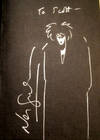
On the Conversion of Electric Oscillations into Continuous Currents by Means of a Vacuum Valve
by FLEMING, JOHN AMBROSE
- Used
- very good
- first
- Condition
- Very Good
- Seller
-
New York, New York, United States
Payment Methods Accepted
About This Item
London: The Royal Society, 1905. First edition. Original wrappers. Very Good. FIRST EDITION IN ORIGINAL WRAPPERS of one of the seminal discoveries of the twentieth-century: the invention of the "Fleming Valve", or vacuum tube, often cited as the beginning of the field of electronics. PMM 396. In 1884, Thomas Edison had demonstrated that "if a metal plate is sealed into an electric light bulb and joined to the positive end of the filament a considerable current will pass. If the plate is joined to the negative terminal, however, no current will pass. This was known as the 'Edison effect' and in 1890 Fleming, an electrical engineer who had worked with the Edison company in London and was now a Professor at University College, began a careful study of this phenomenon in carbon filament lamps. In 1904 he was able to demonstrate that this occurred not only with electric waves but also with wireless waves. He thus introduced the basic principle of the modern wireless valve, which permits only unilateral conductivity. The immense superiority of the Fleming thermionic valve [in the United States, named the vacuum tube] to all previous detectors of wireless waves caused it to be widely used as an efficient and reliable detector" (Printing and the Mind of Man, 396). Several years later, the American inventor Lee DeForest modified Fleming's "diode" vacuum tube, adding a third electrode. Fleming's valve, with DeForest's improvement, would not only result in great advances in broadcasting and wireless communication, but would dominate electronics in general for the next half-century before being replaced by the transistor. Also includes another article by Fleming, "On an Instrument for the Measurement of the Length of Long Electric Waves, and also Small Inductances and Capacities." IN: Proceedings of the Royal Society, Vol. LXXIV, No. 505, pp. 476- 487; March 16, 1905. London: The Royal Society, 1905. Octavo, original printed wrappers, unopened; custom silk box. Small chip and crease to bottom corner of front wrapper, a little wear to spine ends. With rare Index slip and list of papers read laid-in. RARE IN ORIGINAL WRAPPERS.
Reviews
(Log in or Create an Account first!)
Details
- Seller
- The Manhattan Rare Book Company
(US)
- Seller's Inventory #
- 2381
- Title
- On the Conversion of Electric Oscillations into Continuous Currents by Means of a Vacuum Valve
- Author
- FLEMING, JOHN AMBROSE
- Format/Binding
- Original wrappers
- Book Condition
- Used - Very Good
- Quantity Available
- 1
- Edition
- First edition
- Publisher
- The Royal Society
- Place of Publication
- London
- Date Published
- 1905
- Keywords
- transistor, electronics, electricity, vacuum tube, PMM, Printing and the Mind of Men.
- Bookseller catalogs
- Science & Technology;
Terms of Sale
The Manhattan Rare Book Company
30 day return guarantee, with full refund including shipping costs for up to 30 days after delivery if an item arrives misdescribed or damaged.
About the Seller
The Manhattan Rare Book Company
Biblio member since 2010
New York, New York
About The Manhattan Rare Book Company
The Manhattan Rare Book Company offers fine books in all fields, specializing in the important, beautiful, and hard-to-find.
Glossary
Some terminology that may be used in this description includes:
- Spine
- The outer portion of a book which covers the actual binding. The spine usually faces outward when a book is placed on a shelf....
- Wrappers
- The paper covering on the outside of a paperback. Also see the entry for pictorial wraps, color illustrated coverings for...
- First Edition
- In book collecting, the first edition is the earliest published form of a book. A book may have more than one first edition in...
- Laid-in
- "Laid In" indicates that there is something which is included with, but not attached to the book, such as a sheet of paper. The...
- Octavo
- Another of the terms referring to page or book size, octavo refers to a standard printer's sheet folded four times, producing...
- Plate
- Full page illustration or photograph. Plates are printed separately from the text of the book, and bound in at production. I.e.,...


